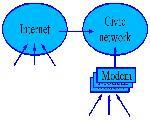Open Source is very attractive for organisations that want to provide cheap and stable communication services. As opposed to the desktop market, the infrastructure arena offers more possibilities for applications on Open Source platforms than for any other. In this case study we look at a province in Italy, which has used Open Source software since 1997 to provide eGovernment services to its citizens. We discuss what was done and how the services evolved over the years.

Introduction
The Italian Province of Cremona, part of the Region of Lombardia, has a surface area of 176 square km, with a total population of just over 330,000 inhabitants. Close to the border of Switzerland, it lies in a mountainous area and is subdivided into 114 municipalities, in most of which live less than 1000 people.
The province has a rich history. Its capital is the city of Cremona, an old city founded in 218 B.C. from a roman colony.
Case
In 1997 the Province of Cremona teamed up with Cremona city, the Chamber of Commerce and the local branch of the Technical University of Milan in a project to set up a civic network. Such a network would on the one hand connect different organisations in the region to a common network, and on the other hand, provide electronic services.
The concept of a civic network was copied from the Region of Milan, where the \'Rete Civica di Milano\' (RCM) was a big success. Cremona liked the idea and wanted to create its own network to improve its relationship with and among the citizens.
In Cremona\'s own words \'a civic network is thought to be a strongly innovative instrument, to which all citizens and associations can connect.\' It was meant not only as a source of information, but also as a means of providing administrative transparency and a distribution channel for teleservices and interactive mass media all at the service of the local community.
First steps
A project was started, called "Rete Civica di Cremona" or RCCR. From the start, it adopted the internet and internet standards as the primary mechanism for communication.
However, back in 1997 not all government services had internet facilities at the workplace. A network only accessible by internet would not be available to organisations like small municipalities and hospitals. The project therefore comprised two components:
- Content
This part of the project focused on providing eGovernment services and content to the users;
- Infrastructure
This subproject provided access to the civic network for all parties involved. For example by providing modem banks, which people could dial into.
Most of the people staffed on the RCCR project came from the Technical University and had already acquired Open Source knowledge. Besides the political benefits, they liked the technology and therefore they decided the network would be powered by Open Source software as much as possible.
From 1997 until 2001 the team built and managed the RCCR, providing access to services like forums, email, calendaring, groupware, room booking and helpdesk applications. All of this was managed within extremely tight budgets. For example the main website ran on a 166MHz Pentium machine up until 2001.

Inevitable evolution
Although the RCCR project was very useful its goals and services became out-of-date compared to the evolving expectations. More specialised initiatives were launched aimed at better serving the visitor\'s needs.
In 2001 RCCR was abandoned. Today, four main areas of service are maintained:
- Intranet
The Intranet provides services for employees of the Province. It evolved from the RCCR intranet, which started out with a non-OSS solution in 1997. Its functionality has seen a lot of extensions over time. All of the new functionality was implemented on Linux, mainly using RedHat 7.3 and 9.
- Internet Services
Examples of internet services are web and application servers, databases, network and security services. All of these are running on standard Linux servers and mainly provided by Open Source software.
- RUP
This portal (\'Rete Unitaria Provinciale\') is dedicated to small organisations and municipalities in the province working together. In the near future it is also going to provide services to citizens. Content and services are managed by a special team who maintain the full integration with the internet services mentioned above. On top of these internet services, RUP provides services like email and web space to municipalities or local governments.
- e-Cremona
A portal aimed at citizens. It provides access to online information and services such as news, banking and electricity services. The contents are provided and managed by parties other than the Province, ie. news papers, banks and utility companies.

Evaluation
The RCCR project and its successors have proven to be good learning environments for working with Open Source software.
Gianni Bassini, system administrator for the Province, comments: \'The RCCR project first introduced Open Source to Cremona. Although most technical people in the project had previous experience with Open Source software, it proved challenging to set up the initial environment. On the one hand this was not specific to Open Source, but because it is simply not easy to set up a full-scale professional internet environment. On the other hand things that were specific to the use of Open Source software, like installation and configuration, took a little time in the beginning. After a while however, we found that nearly all issues could be systematically solved by using the abundance of information available on the internet, such as manuals and discussion groups.\'
From the side of the users people generally liked the idea of a civic network. They soon started to use the provided forums to have discussions about the province\'s policies and their execution, for instance whether or not to create new roads.
Overall the province considers its move to eGovernment a success so far. The implementation of the services have proven reliable and valuable enough to earn the trust of its inhabitants.
Open Source has played a crucial role in this success. It not only allowed the project team to set up all services with a very limited budget but also enabled them to tailor applications to the needs of the users. An example is the room booking system, which was freely available on the internet, but only in English. The fact that it is distributed under an Open Source license allowed the team to translate the application into Italian and use its functionality practically out-of-the-box.
Future
Since 1997 the deployment of Cremona\'s e-services has matured and become more professional. The province is placing more and more information online and planning more improvements in services, for example by adding features for cartography and environmental planning. In the near future they also want to add specialized content management features for market sectors like agriculture and transport.
On the technical level things are also continuing to move. With technology progressing and faith in Open Source software strong, people have recently started to investigate the possibility of moving to a combined SOAP/Java implementation for the portal. Also, some of the province\'s content databases are currently being merged to achieve better manageability. The software for this is written by an external party and paid for by the province. Once finished, it is expected to be released under the GPL license.
References
e-Cremona homepage
RUP homepage
Paper version of this case study
Open Source drives Italian eGovernment (PDF)[174 Kb]
© European Communities 2004
Reproduction is authorised provided the source is acknowledged.
The views expressed are not an official position of the European Commission.
Disclaimer

